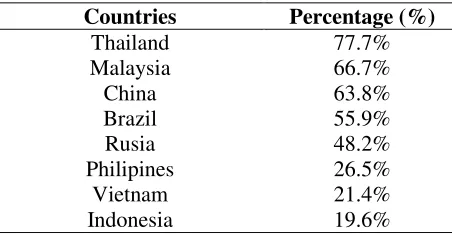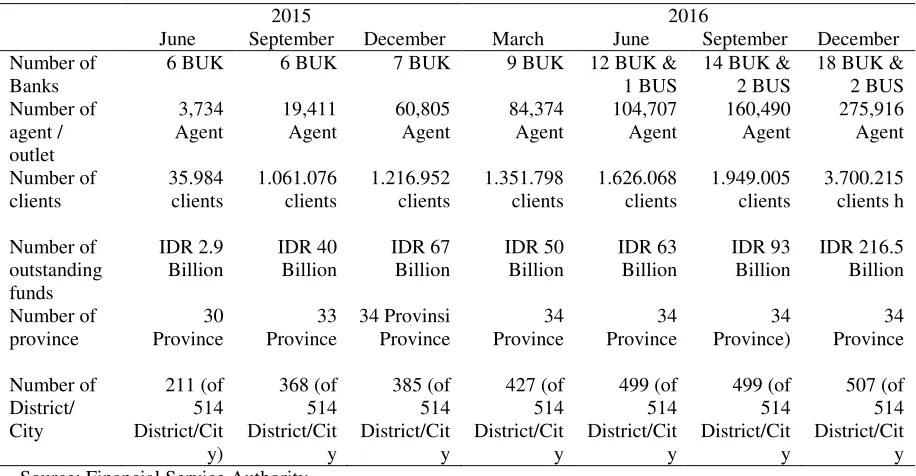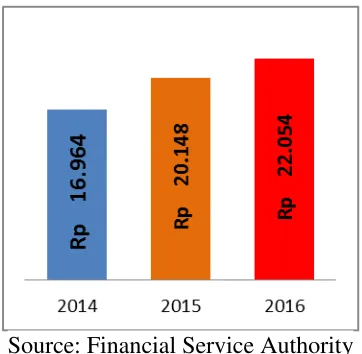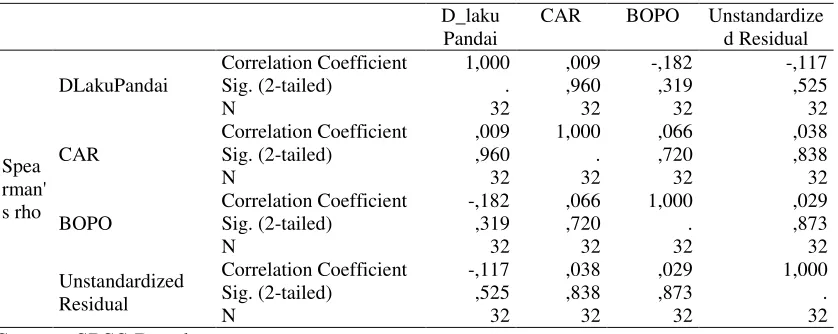Al Arif and Firmansyah: Laku Pandai’s Program and Deposit Fund:...
Laku Pandai’s Pr
ogram And Deposit Funds: Study At Bank
Of BRI Sharia
M. Nur Rianto Al Arif1, Firmansyah2
1UIN Syarif Hidayatullah Jakarta, 2Uhamka
1mnur.rianto@uinjkt.ac.id, 2syahfirman584@gmail.com
Abstract: Laku Pandai’s program is one of the policies that implemented by the financial service authority (OJK) to expand the banking service to the people. One of the Islamic banks that had implemented the program is Bank of BRI Sharia. This research is going to
examine the effectiveness of Laku Pandai’s program to deposit funds in Bank of BRI Sharia. This study using regression with the dummy variable. The result shows that there is a difference between pre and post-Laku Pandai’s program in Bank of BRI Sharia. This
result implies that the Laku Pandai’s implementation had an impact on increasing deposit funds in Bank of BRI Sharia. So, it is recommended to add more Islamic banks that
implemented the Laku Pandai’s program
Keyword: Laku Pandai’s program, deposit funds, multiple regressions
Abstrak: Program Laku Pandai merupakan salah satu kebijakan yang dikeluarkan oleh otoritas
jasa keuangan (OJK) untuk memperluas layanan perbankan kepada seluruh lapisan masyarakat. Salah satu bank syariah yang telah menerapkan program Laku Pandai ialah Bank BRI Syariah. Penelitian ini bertujuan untuk menguji efektivitas program Laku Pandai terhadap penghimpunan dana pihak ketiga di bank BRI Syariah. Adapun teknik analisis yang dipergunakan ialah regresi berganda dengan variabel dummy. Hasil penelitian menunjukkan bahwa terdapat perbedaan dana pihak ketiga antara sebelum dan sesudah penerapan program Laku Pandai di Bank BRI Syariah. Hal ini menunjukkan bahwa penerapan program Laku Pandai di Bank BRI Syariah telah mampu meningkatkan dana pihak ketiga. Oleh karenanya penelitian ini merekomendasikan untuk lebih banyak lagi bank syariah yang menerapkan program Laku Pandai.
Kata Kunci: program Laku Pandai, dana pihak ketiga, regresi berganda.
INTRODUCTION
To extend the banking services to all levels of society, financial service authority (FSA/OJK) launched the program of Laku Pandai (Layanan Keuangan Tanpa Kantor dalam rangka Keuangan Inklusif) since 2015. Initially, the program was followed by six banks, such as Bank of Mandiri, Bank of BRI, Bank of BNI, Bank of BTN, Bank of BTPN, and Bank of BCA. Along with the development, until the end of 2016, there have been 12 conventional banks and one full-fledged Islamic banks that have joined the Laku
Pandai’s program.
This research will examine the effectiveness of Laku Pandai’s program between pre and post-program in Bank of BRI Sharia. Bank of BRI Sharia becomes the object of this study because it is the only full-fledged Islamic banks that follow the Laku Pandai’s program. The findings of this research obtained indicate that there are differences of
deposit funds between before and after the implementation of Laku Pandai’s program in
Bank of BRI Sharia. Therefore, the findings of this study are in line with the objectives of
Al Arif and Firmansyah: Laku Pandai’s Program and Deposit Fund:...
The financial service authority launched the Laku Pandai’s program because it sees on the
condition in Indonesia. There are still many Indonesian people who do not know banking services, either for saving or get loan facility. The banking services in Indonesia still do not reach all areas in Indonesia, especially in remote locations. This problem arises because the cost incurred for the opening the branch office in remote regions, such as rental cost, administration cost, human resources cost, technology cost, etc. This problem makes a lot of Indonesian people still not touchable to the banking services.
Based on data from Bank Indonesia, to serve 250 million Indonesians, banks are more focused on building branch offices. The banking services in Indonesia have 18,000
branches, 7,000 ATM’s machines, and 4,000 rural bank’s offices. Based on the number of
services, it is only able to serve 20% of the society or only 30 million of productive people. This fact is very left behind if compared with neighboring countries, such as Malaysia or Thailand. The main issues are the portion of office opening investment is higher than the expansion of access to information technology. Thailand with 33 commercial banks and 56,000 branches can reach 73% of productive people. Malaysia with 15,000 branches can reach 66% of productive people (Prasetyo, 2015).
The fact also supported with the data from World Bank: Global Financial Inclusion Index (Findex) in 2011, which is only 19.5% of people in Indonesia that had an account in banks. If we compare with neighboring countries such as: Malaysia (66.7%), Thailand (77.7%), China (63.8%), Brazil (55.9%), Rusia (48.2%), Philippines (26.5%), and Vietnam (21.4%).
Table 1. Number of Adult People That Have Account in Bank
Countries Percentage (%)
Thailand 77.7% Malaysia 66.7%
China 63.8%
Brazil 55.9%
Rusia 48.2%
Philipines 26.5% Vietnam 21.4% Indonesia 19.6%
Source: World Bank: Global Financial Inclusion Index (Findex)
According to the financial literacy national survey by financial service authority in 2013, the literation index in Indonesia to banking industry shows the number 22%. This figure means that in every 100 Indonesian people, only 22 people that had knowledge and confidence with the banking products. From the same survey, we can also get the result of utility index of banking products and services. The result shows the number of 57%; it means only 57 of 100 people had utilized banking products and services. From financial service authority survey shows that almost Indonesian people used the products and services in banking without adequate understanding.
Al Arif and Firmansyah: Laku Pandai’s Program and Deposit Fund:...
financial inclusive that had developed by the government. These strategies also realized by the financial service authority to banking and financial industry. The inclusive financial means that the condition, which all of the people can reach the financial access service with quickly. Besides that the financial inclusive means that the people had a tradition to optimize the utilization of financial services.
The Laku Pandai’s program is the extension of branchless banking programs. The branchless banking’s program is non-office bank services. This program is not using offices networking, but using information technology in its operation. This program requires cooperation from other parties, namely the agent, which is an extension of the bank to give the financial services to the people. The target of this program is people who do not know, use, and/or obtain the banking and other financial services. According to the Bank of Indonesia, the non-office services is the concept of banking service providers outside the conventional form in general, both by using information communication and technology services, or, by using the third parties involvement.
Table 2. The Development of Laku Pandai. 2015-2016
2015 2016
June September December March June September December
Number of
*) Note: BUK is Conventional banks; BUS is full-fledged Islamic banks
According to the Table 2, we can see that the numbers of the agent (either individual or group) had increased significantly. Besides that, there is also an increase in numbers of outstanding funds in each month. According to the data, we can see the diversity of Laku
Pandai’s agents still concentrated in Java. The data imply that the agent's diversity still not
equal to the outside of Java, such as: in Maluku, Sumatera, Kalimantan, and Sulawesi. Bank of BRI Sharia is the first full-fledged Islamic bank that had implemented the
Laku Pandai’s program. This program is suitable with the inclusive financial goal from the
Al Arif and Firmansyah: Laku Pandai’s Program and Deposit Fund:...
are no minimum balance, free administrative fees, and the availability of mobile banking applications for the customers.
Figure 1. The Growth of Deposit Funds. 2014-2016
Source: Financial Service Authority
After the program implementation, Bank of BRI Sharia has obtained 859 customers and 284 agents (until the end of 2016). The number of customers and agents is expected to increase in the future. The number of deposit funds has grown after the program’s implementation (see Figure 1). The branchless banking program does not require the establishment of a branch office but requires the cooperation with a third party (agents). Besides that, the program also needs a good telecommunication network and the promotion cost.
Sarah (2015) said that there are several elements should consider by the banks to
implement the branchless banking programs (such as Laku Pandai’s program). First, the
capital aspect becomes an early consideration when implementing this program. This will useful to measure the capital ability to close the loss potential. The efficiency issue will be
the second element for banks’ consideration. The efficiency will measure the ability of banks’ management in control the operational cost.
METHOD
This research is using the quantitative method with time series data. The method that used in this research is multiple linear regression with the dummy variable. This study aims to
analyze the impact of Laku Pandai’s program to the deposit funds. The data that used in this research is quarterly financial reports from 2009-2016. The mathematical equation that applied in this study can be seen as follows:
LnDPKt= α + β1 D_LPt+ β2 CARt+ β3 BOPOt + ɛt
Where: Ln DPK is natural log of deposit funds; D_LP is dummy of Laku Pandai’s
program; Which: 0 = before; 1 = after; CAR is capital adequacy ratio BOPO is operational efficiency ratio
Al Arif and Firmansyah: Laku Pandai’s Program and Deposit Fund:...
achieved. After that, we will do the hypothesis test, which includes: the t-test, F-test, and determination coefficient (adjusted R-square).
RESULT AND DISCUSSION
Result. The first test we had done in this research is the classical assumption tests, which is includes: normality test, heteroscedasticity test, multicolliniearity test, and autocorrelation test. The normality test with using Kolmogor-Smirnov test shows that the data had normally distributed (see Table 3).
Table 3. The Normality Result
Unstandardized Residual
N 32
Normal Parametersa,b Mean ,0000000
Std. Deviation ,46694946
Most Extreme Differences
Absolute ,202 Positive ,115 Negative -,202
Kolmogorov-Smirnov Z 1,140
Asymp. Sig. (2-tailed) ,148
Source: SPSS Result.
The next classical assumption test is heteroscedasticity test. According Table 4 shows that there is no heteroscedasticity problem in this model. Table 5 shows the multicolliniearity test. The result shows that the value of VIF for each variable is 1.034, 1.054, and 1.055. This result implies that there is no multicolliniearity in this model.
Table 4. The Heteroscedasticity Result
D_laku Pandai
CAR BOPO Unstandardize
d Residual
Spea rman' s rho
DLakuPandai
Correlation Coefficient 1,000 ,009 -,182 -,117
Sig. (2-tailed) . ,960 ,319 ,525
N 32 32 32 32
CAR
Correlation Coefficient ,009 1,000 ,066 ,038
Sig. (2-tailed) ,960 . ,720 ,838
N 32 32 32 32
BOPO
Correlation Coefficient -,182 ,066 1,000 ,029
Sig. (2-tailed) ,319 ,720 . ,873
N 32 32 32 32
Unstandardized Residual
Correlation Coefficient -,117 ,038 ,029 1,000
Sig. (2-tailed) ,525 ,838 ,873 .
N 32 32 32 32
Source: SPSS Result
Al Arif and Firmansyah: Laku Pandai’s Program and Deposit Fund:...
Table 5. The Multicollinearity Result
Model Collinearity Statistics Tolerance VIF
laku pandai ,967 1,034
Car ,949 1,054
BOPO ,948 1,055
Source: SPSS Result
The result of multiple regressions in Table 6 shows that there is a difference in deposit
funds between pre and post the Laku Pandai’s program in Bank of BRI Sharia. The
positive sign implies that there is a positive relationship between the Laku Pandai’s program and deposit funds. It means that the implementation of Laku Pandai’s program can increase the movement of deposit funds in Bank of BRI Sharia. The Laku Pandai’s program is one of the strategy to expand the networking of banks, especially to attract the new customer and to increase the deposit funds.
The control variables such as: capital adequacy ratio (CAR), operational efficiency ratio (BOPO) had a different result for each other. The capital adequacy ratio had an impact on the deposit funds. The increase in the CAR ratio will be able to increase deposit funds in Bank of BRI Sharia. It implies that the bank should always strengthen the capital; it will attract the customer to increase their deposit in bank. The Laku Pandai’s program hopefully can be one of the strategies to strengthen the capital requirement in bank of BRI Sharia.
The variable that had no impact on deposit funds is operational efficiency ratio (BOPO). The data shows that the operational efficiency ratio in bank of BRI Sharia is still above 90%. It means that the bank still not efficiency in banking operations. The Laku
Pandai’s program is one of the strategies to decrease the operational cost in Bank of BRI Sharia. The Laku Pandai’s program can expand the networking with least additional cost.
Table 6. The Multiple Regressions Result
Model Unstandardized Coefficients Standardized Coefficients
t Sig.
B Std. Error Beta
1
(Constant) 31,238 1,554 20,105 ,000 DLakuPandai ,830 ,243 ,318 3,414 ,002 CAR -,106 ,013 -,777 -8,265 ,000
BOPO ,003 ,016 ,015 ,164 ,871
Source: SPSS Result
According to the F test result, it shows that all of the independent variables had an impact on dependent variable. It implies that the variable of Laku Pandai, capital adequacy ratio, and operational efficiency ratio had an impact on deposit funds in Bank of BRI Sharia. The detail of this result can be seen in Table 7.
Al Arif and Firmansyah: Laku Pandai’s Program and Deposit Fund:...
Table 7. The F-test Result
ANOVAa
Model Sum of
Squares
df Mean Square F Sig.
1
Regression 22,000 3 7,333 30,378 ,000b
Residual 6,759 28 ,241 Total 28,760 31
Source: SPSS Result.
Table 8. The Coefficient Determination Result
Model R R Square Adjusted R Square
Std. Error of the Estimate
1 ,875a ,765 ,740 ,49133
Source: SPSS Result
Discussion. The Laku Pandai’s program is the extension of branchless banking thad had implemented by several banks. In branchless banking program, banking operations are
still fully operated by banks. While in the Laku Pandai’s program, the operational done by
the third party that acting as an agent of the banks. Tandika and Sevriana (2017) stated
that the Laku Pandai’s program is the adoption of financial inclusive service.
One of the Islamic banks that had implemented the branchless banking is Bank of BJB Sharia, the program called by Jemput Mashlahah program. Adzkia (2014) shows that the Jemput Mashlahah’s program had an impact to increase the deposit funds in Bank of BJS Sharia. Nagendra and Shenoy (2011) stated that the inclusive service without branch had a goal to extend the banking networking to the people.
The Laku Pandai’s program that had launched by the Financial Service Authority is one of strategies to attract more people in Indonesia to deal with the banking services. The data in Table 1 shows that only 19.6% of adult people in Indonesia had the account in banks, especially in middle-low people. The Laku Pandai’s program is one ways to get closer with the middle-low society. Chege and Nieru (2016) shows that the middle-low people only want to deal with the financial services if they feel secure with the services. Trust is one factor to foster a sense of secure and comfort to the society. The trust factor
that can determine the successful of the branchless program, include the Laku Pandai’s
program (Chaudhary, et al, 2016; Olimov, et al, 2017; Maina and Mwangi M, 2017). The Laku Pandai’s program is one of the solutions to solve one of the weaknesses in the Indonesian Islamic banking industry. According to ngrif (2011) and Rusydiana (2016),
one of the weaknesses from Islamic banking in Indonesia is branch’s networking. Islamic
banking had limited capital to expand the networking; the Laku Pandai’s program is one of the strategies to expand the networking with minimum cost. Prasetyo and Sunaryo (2015) conclude that the increase of branch office numbering not always linier with the financial performance of banking industry.
Therefore, the expansion of inclusive banking access is particularly important to
improving the competitiveness of the banking industry in Indonesia. The Laku Pandai’s
programs should also implement by the spin-off’s banks. This result is in line with Haribowo (2017). She suggested that the spin-off policy should support by other policies.
Al Arif and Firmansyah: Laku Pandai’s Program and Deposit Fund:...
spin-off policy. Spin-off’s bank must have limited resources to expand the networking; the
Laku Pandai’s program can be one of the solutions to decrease their cost.
Inclusive banking services using agents can be an important service in promoting economic growth in a country (Mahmood and Sarker, 2015). Therefore, banks should be able to have a long-term relationship between the organizers of smart conductors and agents. According to Taat (2016) there are four factors that affect long-term cooperation relationship between the organizer bank and the agent, namely: trust, dependency, communication, and commitment.
CONCLUSION
The empirical result shows that there is a difference in deposit funds between pre and post-Laku Pandai’s program. This result implies that this program can expand the access and network of banking services to the communities. The program must
accompany by the quality service’s improvement. This program will increase the trust and
conformity of the user to the transaction using Laku Pandai.
This research recommended several things, such as: first, the Islamic banks, especially for spin-off's banks, should implement the Laku Pandai’s program to expand the access and network. Second, the banks should prioritize the safety and convenience factors of customers. Third, the financial service authority (OJK) should give a special treatment for the banks that had implemented this program.
REFERENCES
Adzkia, M.F. (2014). “Efektivitas Program Layanan Jemput Maslahah dalam Meningkatkan Dana Pihak Ketiga pada PT BJB Syariah Cabang Pajajaran Bogor”.
Unpublished Bachelor Thesis. Jakarta: UIN Syarif Hidayatullah Jakarta.
Al Arif, M.N.R. (2011). Dasar-Dasar Ekonomi Islam. Solo: Era Adicitra Intermedia. Anggraeni, N. (2015). “Pengaruh Layanan 3 in 1 Mashlahah (Branchless Banking)
terhadap Pertumbuhan Dana Pihak Ketiga (DPK) dan Efisiensi Biaya Operasional Bank pada PT. Bank BJB Syariah”. Unpublished Bachelor Thesis. Universitas Islam Bandung. Bandung.
Chaudhary, A.A., et.al. (2016). “Determinants of Users Trust for Branchless Banking in Pakistan”. Journal of Internet Banking and Commerce. 21 (1), 1-15.
Chege, K.D. & Njeru, A. (2016). “Influence of Branchless Banking Services on Saving Practices in Informal Settlements of Kenya: A Case Study of Kibera”. International
Journal of Science and Research. 5 (10), 1264-1273.
Haribowo, I. (2017). “The Indonesian Islamic Bank’s Spin-off: A Study in Regional Development Banks”. Al-Iqtishad: Jurnal Ilmu Ekonomi Syariah (Journal of Islamic
Economics). 9 (1), 53-68.
Mahmood, R. & Sarker, S. (2015). “Inclusive Growth Through Branchless Banking: A Review of Agent Banking and Its Impact”. Journal of Economics and Sustainable
Development. 6 (23), 86-93.
Al Arif and Firmansyah: Laku Pandai’s Program and Deposit Fund:...
Nagendra, S. & Shenoy, N. (2011). “Financial Inclusion via Branchless Banking to Extend the Outreach- Case Study of Corporation Bank”. International Journal of Advanced
Research in Management and Technology. 1 (1), 29-58.
Prasetyo, H. & Sunaryo, S. (2015). “The Branch Expansion and The Performance of the Banks: The Case of Indonesia”. Buleting Ekonomi Moneter dan Perbankan. 18 (1): 85-106.
Rusydiana, A.S. (2016). “Analisis Masalah Pengembangan Perbankan Syariah di Indonesia: Aplikasi Metode Analytic Network Process”. Esensi: Jurnal Bisnis dan
Manajemen. 6 (2), 237-246.
Sarah, H. (2015). “Dampak Branchless Banking Terhadap Kinerja Keuangan PT. Bank Muamalat Indonesia Tbk”. Jurnal Muzaraah. 3 (5), 136 - 157.
Taat, R.M. (2016). “Analisis Variabel yang Mempengaruhi Hubungan Kerjasama Jangka Panjang Antar Bank Penyelenggara Laku Pandai dan Agen”. Jurnal Ilmiah
Mahasiswa FEB Universitas Brawijaya. 4 (2), 201-210.
Tandika, D. & Sevriana, L. (2017). “Adopsi Terhadap Inovasi: Kajian Konseptual Implementasi Program Laku Pandai Pada Layanan BRILink”. Performa: Jurnal
Manajemen dan Bisnis. 14 (1), 53-64




